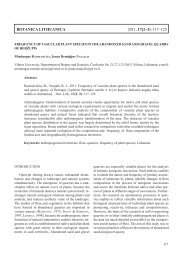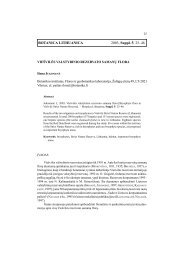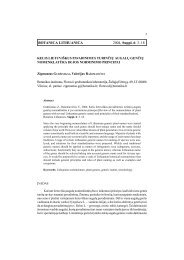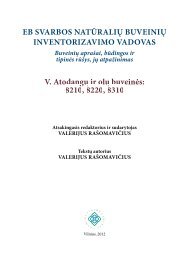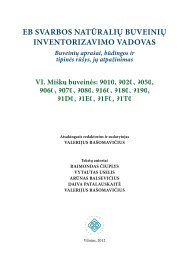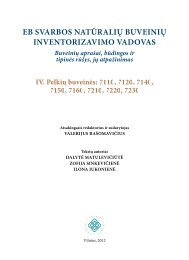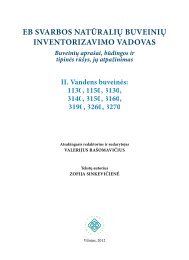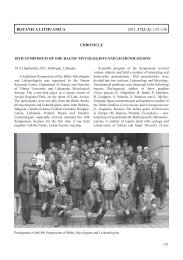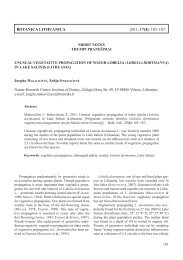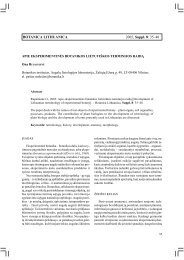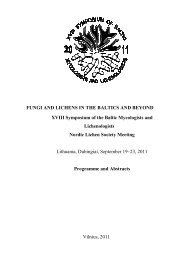ascertained. Micromycetes Alternaria brassicae, A. pluriseptata,Chrysosporium merdarium, Fusarium solani,Fusarium sp. 1-pK, Penicillium expansum, Penicilliumsp. sv.-161-1 are able to produce toxic metabolites intensively.From grain of spring barley ‘Luokë’ and winterwheat ‘Zentos’ micromycetes were isolated, identifiedand their ability to produce deoxinivalenol and zearalenonwas tested. When micromycetes of 12 species ofthe Fusarium genus were tested, it was established thatdeoxynivalenol was produced the most intensively byFusarium sporotrichioides 4 (1.20 mg/kg) and F. equiseti6 (0.800 mg/kg), zearalenon – by F. chlamydosporum7 (0.468 mg/kg) and F. equiseti 6 (0.564 mg/kg). Themost interesting and dangerous are those strains, whichare capable of producing two or more toxic derivatives.Carrying out the screening of mycotoxin’ producentsthe thin-layer chromatography constants for secondarytoxic metabolites (T-2, nivalenol, zearalenon, altemuen,tenuazonic acid) were determined (Table 1, Table 3). Tendifferent micromycetes were detected basing on the toxinsproduced into agar of Czapek-yeast extract (CYA)and Yeast extract sacharose (YES). Using solvent systemsdescribed in the Materials and Methods, 6 derivativesflorescent under UV light from Aspergillus fumigatuswere found. Their Rf was from 0.46 to 0.91. Fusariumsporotrichioides produced 4 derivatives, which Rfwas from 0.13 to 0.89. One derivative (Rf = 0.42) wasidentified as T-2 toxin. Penicillium variabile released4 derivatives, which Rf was from 0.06 to 0.88. The derivative,which Rf = 0.87 was identified as patulin andthe derivative with Rf = 0.88 – penitrem. Fusarium poaeproduced 1 derivative with Rf = 0.87, which was identifiedas T-2 toxin. Penicillium viridicatum secreted 7derivatives, which Rf was from 0.63 to 0.89. The derivativewith Rf = 0.51 was identified as ochratoxin, andthe peripheral derivative with Rf = 0.68 – tenuazonicacid. In the extract of Fusarium tricinctum 2 derivativeswith Rf = 0.14 and 0.89 were detected. The latter derivativewas identified as T-2 toxin. Fusarium equisetiproduced 5 derivatives, which Rf was from 0.14 to 0.89.The derivative with Rf = 0.63 is close to citochalazine.In extracts of Alternaria alternata there were 7 components,one of them (Rf = 0.69) was identified as tenuazonicacid, the other one (Rf = 0.83) – sterigmatocistin,the third one (Rf = 0.63) was close to citochalazin. Trichosporiellacerebriformis produced 7 derivatives withRf from 0.06 to 0.89. The derivative with Rf 0.59 wasclose to patulin. The content of mycotoxins was determinedin wheat bread contaminated by micromycetesFusarium tricinctum, Penicillium variabile and Fusariumsp. In bread samples high amounts of T-2 toxinwere found – 0.9441 and 0.8971 mg/kg. Micromycetesof the Penicillium genus able to produce patulin, ochratoxin,penitrem, citochalazin, tenuazonic acid, sterigmatoxinand other toxins were isolated from variousfood sources (Table 6).The most active ochratoxin producers were Penicilliumgriseofulvum (= P. citreoviride), P. spinulosum,P. waksmani and P. italicum. Micromycetes capable ofproducing a wide spectrum of toxic substances of variouschemical compositions were screened and deposited topure culture collection. According to the obtained datasuch micromycetes were Penicillium expansum sv.-168-1,Penicillium sp. sv.-161-1, Fusarium solani F-08, Alternariaalternata B-230-1, A. pluriseptata B-230-3, Ulocladiumoudemansii B-230-2, Aspergillus (=Eurotium)raperi 2-Sal. Other micromycete strains were weakertoxin producers. Cladosporium chlorocephalum 3-ph,which was spread on barley grain, produced a substance(Rf = 0.89) close to sterigmatoxin. This was specific tostrains Scytalidium lignicola G-453 and Alternaria sp.M-447. It was found out that the same strains growingon different substrates produce different amounts ofmycotoxins such as deoxyvalenol (DON) and zearalenon(Table 7).Contamination of food raw material and products bymicromycetes is determined by their distribution in theenvironment; especially it is evident during storage ofgrain, vegetables and fruit. Just after the transportationof grain yield (2003–2004) to storehouses, several micromycetes– potential producers of toxic metabolites –were detected on both grain surface and inside the grain.These were the following: Alternaria alternata, Fusariumavenaceum, F. graminearum, F. poae, F. tricinctum,F. solani, F. sporotrichioides, Penicillium aurantiocandidum,P. expansum and P. funiculosum. Latercereal grain and their processed products are contaminatedmostly by Penicillium verrucosum, P. variabile,P. expansum, Aspergillus clavatus, A. niger, Drechslerasorokiniana and Rhizopus oryzae, while counts of Fusariumpoae, F. sporotrichioides and Alternaria alternatadecrease. A specific composition of micromycetes wasdetermined on seeds of rape, flax, maize and soy andthe processed products. Fungi Aspergillus niger, Fusariumoxysporum, Penicillium expansum, Alternaria alternata,Fusarium avenaceum, Rhizomucor pusillus, Aspergillusclavatus, A. versicolor, Penicillium palitans,P. roquefortii, P. viridicatum and P. verrucosum weredetected most frequently. These fungi were prevalentalso in the air of grain storehouses as well as in vegetableand fruit storehouses.According to the method of thin-layer chromatographyby FRISVALD & THRANE (2000) exogenic metabolitesproduced by micromycetes, isolated from tested72
Table 7.Ability of Fusarium strains, isolated in 2004 from summer barley ‘Luokë’ and winter wheat ‘Zenta’, to producetoxinsSpecies Source Deoxynivalenol (mg/kg) Zearalenon (mg/kg)Fusarium chlamydosporum Barley 0.06 0.468F. semitectum Barley 0 0F. sporotrichioides Barley 0.045 0.1F. oxysporum Barley 0.025 0.013F. merismoides Barley 0.085 0.002F. poae Wheat 0.07 0F. oxysporum Wheat 0 0F. sambucinum Wheat 0 0.008F. sporotrichioides Wheat 1.20 0.263F. moniliforme Wheat 0 0F. equiseti Wheat 0.8 0.564F. nivale Wheat 0.085 0.0025samples, were analyzed. More than a half (58 %) of allinvestigated fungal strains more or less intensively producedsecondary metabolites, among which from 1 to7 toxic ones were found. Only a part of metabolites wereidentified because of the absence of the standard toxins.The fact that micromycetes produce a wide spectrumof toxins confirms the opinion about risk of toxic fungalmetabolites to human health. It should be noticed thatthis effect manifests slowly only after some time and invarious forms.It was found out that most of micromycetes detectedon food raw material and food products of plant originare able to synthesize one or several toxins. In 2003–2004 these toxic substances were identified:• T-2 (tetraol) – produced by Fusarium graminearum,F. poae and F. sporotrichioides• Fusarenone X – produced by Fusarium graminearum• Nivalenol – Microdochium nivale• Deoxynivalenol – Fusarium graminearum, F. culmorum• Alternuene – Alternaria alternata• Alternariol – Alternaria alternata, A. brassicae, A. cucumerina• Zearalenon – Fusarium tricinctum, F. graminearum,F. lateritium, F. culmorum, F. moniliforme, F. avenaceumand F. sambucinum• Tenuazonic acid – Alternaria alternata, A. brassicae,A. radicina A. longipes, A. tenuissima, Pyriculariaoryzae, Phoma sp.• Patulin – Penicillium expansum, P. claviforme, P. granulatum,P. lanosum, P. mellini, P. cyclopium, P. cyanofulvum,P. roquefortii and Aspergillus clavatus• Penitrem A – Penicillium palitans, P. cyclopium, P. puberulum,P. spinulosum, P. verrucosum• Penitrem B – Penicillium palitans and P. verrucosum• Citochalazin group – Aspergillus clavatus, Metarrhiziumanisopliae, Chaetomium globosum, Drechslerasorokiniana, Phoma sp.• Ochratoxin A – Aspergillus ochraceus, A. sulphureusand Penicillium viridicatum• Ochratoxin B – Aspergillus ochraceus• Aflatoxin B2 – Aspergillus flavus and A. parasiticus• Sterigmatocistins – Drechslera sorokiniana, Aspergillusversicolor and A. ustusThe obtained data on mycotoxin producers and theirtoxins will enable investigators to develop comprehensiveprotection system from mycotoxin contamination;will allow to reduce contamination of food by mycotoxinproducers and with their toxic metabolites in allfood production and sale links. Analysis of the obtaineddata shows that the problem of limitation of spreadingand development of micromycetes in food raw materialand products still remains. To determine effective measuresinactivating development and functional activity ofmicromycetes, it is necessary to investigate diversity ofmicromycetes and their toxic metabolites in food rawmaterial and products. Thus, it is suggested to continuethis investigation in order to develop preventive protectionmeasures enabling to reduce spreading of micromycetesand synthesis of their toxic secondary metabolites.73



